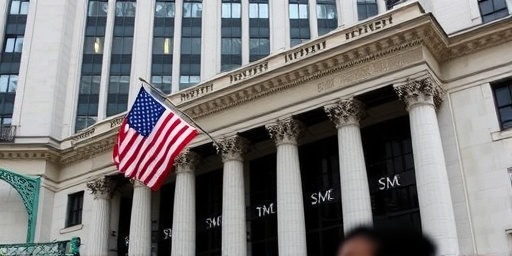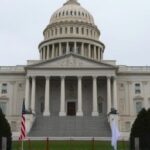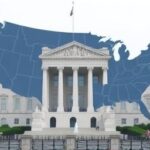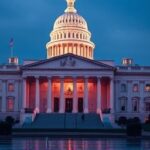In a swift response to a mounting crisis of fraud and escalating loan losses, major Wall Street institutions are overhauling their lending standards. Leading banks, including JPMorgan Chase and Bank of America, have announced enhanced due diligence protocols that require borrowers to submit extensive documentation, undergo rigorous background checks, and face prolonged approval timelines. This shift comes after a series of high-profile scandals that have wiped out billions in assets, shaking investor confidence and prompting calls for stricter oversight across the financial sector.
The changes, detailed in internal memos and regulatory filings obtained by this outlet, mark a significant departure from the aggressive lending practices that fueled recent economic growth. Industry analysts estimate that fraud-related loan losses exceeded $10 billion in the last fiscal year alone, with cases involving falsified income statements, identity theft, and insider manipulations at the forefront. As one executive from a top-tier investment bank put it, “We’ve been too trusting; now, we’re building walls where there were once open doors.”
Recent Fraud Scandals Ignite Wave of Loan Losses
The catalyst for these tightened lending standards on Wall Street is a series of devastating fraud incidents that have exposed vulnerabilities in the lending ecosystem. In the past 18 months, at least a dozen major cases have surfaced, each involving sophisticated schemes that bypassed traditional verification processes. For instance, a prominent case in New York involved a real estate developer who secured over $500 million in loans using fabricated financial records, leading to defaults that cost lenders dearly.
According to a report from the Federal Deposit Insurance Corporation (FDIC), loan losses tied to fraud jumped by 45% in 2023, reaching levels not seen since the 2008 financial crisis. Small business loans, commercial real estate financing, and personal lines of credit have been particularly hard-hit. One notable scandal at a regional bank subsidiary revealed how employees colluded with borrowers to inflate asset values, resulting in $2.3 billion in write-downs. “This isn’t just about rogue actors; it’s a systemic issue where rapid digital lending outpaced risk controls,” said Sarah Kline, a financial regulatory expert at the Brookings Institution.
Statistics paint a grim picture: The American Bankers Association reports that fraud attempts on loan applications rose by 62% year-over-year, with digital platforms being the primary vector. Cybercriminals have exploited AI-generated documents and deepfake technologies to impersonate executives, tricking underwriters into approving high-risk loans. In response, Wall Street firms are investing heavily in forensic accounting tools and third-party verification services, but the damage from past lapses lingers, eroding profit margins and shareholder value.
Banks Implement Stringent Due Diligence Overhauls
To combat the rising tide of fraud, Wall Street banks are rolling out comprehensive due diligence enhancements that go beyond surface-level checks. JPMorgan Chase, the largest U.S. bank by assets, has mandated biometric authentication for all high-value loan applications, alongside mandatory audits of borrower tax returns spanning five years. “We’re not just verifying identities; we’re dissecting financial histories,” a spokesperson for the bank confirmed in a statement released last week.
Similarly, Citigroup and Wells Fargo are integrating advanced analytics platforms that cross-reference loan data with public records, credit bureaus, and even social media footprints. This multi-layered approach aims to flag anomalies early, such as discrepancies in income reporting or unusual transaction patterns. The cost of these upgrades is substantial—estimated at $1.5 billion industry-wide in 2024—but executives argue it’s a necessary bulwark against further loan losses. A survey by Deloitte of 200 financial institutions found that 78% plan to increase due diligence budgets by at least 20% this year.
These measures extend to partnerships with fintech firms specializing in fraud detection. For example, Goldman Sachs has partnered with a startup using machine learning to predict fraud risks with 95% accuracy, based on historical loan losses data. However, implementation isn’t without challenges; smaller banks complain that the heightened scrutiny could stifle lending to underserved communities, potentially exacerbating economic inequalities.
Borrowers Navigate New Hurdles in Loan Approvals
The ripple effects of stricter lending standards are being felt acutely by borrowers across the spectrum, from startups seeking venture debt to homeowners refinancing mortgages. Approval times have ballooned from an average of 10 days to over a month in many cases, as banks demand reams of additional data—including notarized affidavits, third-party appraisals, and even references from past lenders. “It’s like applying for a loan now requires a full background investigation,” lamented Maria Gonzalez, a small business owner in Chicago who waited six weeks for a $250,000 line of credit.
Real estate developers, a sector plagued by fraud-induced loan losses, are facing the steepest barriers. Projects that once sailed through underwriting are now stalled, with lenders requiring environmental impact assessments and detailed cash flow projections. The National Association of Realtors estimates that these delays could reduce new construction starts by 15% in urban markets. On the consumer side, personal loans for debt consolidation are seeing rejection rates climb to 30%, up from 18% last year, according to Experian data.
Yet, some borrowers see silver linings. Enhanced due diligence is weeding out predatory practices, ensuring that only viable projects get funded. Tech entrepreneur Raj Patel, whose fintech startup secured funding after a thorough vetting, noted, “The process was grueling, but it built trust with investors who were wary after recent scandals.” Still, advocacy groups like the Consumer Financial Protection Bureau warn that overzealous checks could limit access to capital for low-income applicants, calling for balanced reforms.
Regulators Push for Broader Industry Reforms
As Wall Street tightens its lending standards, federal regulators are amplifying their role to address the root causes of fraud and loan losses. The Office of the Comptroller of the Currency (OCC) has issued new guidelines mandating annual due diligence training for all lending staff and the adoption of standardized fraud-reporting protocols. “We can’t let complacency breed another crisis,” OCC Director Michael Hsu stated during a congressional hearing last month.
The Securities and Exchange Commission (SEC) is also probing several Wall Street firms for alleged lapses in oversight, with potential fines in the hundreds of millions. A landmark settlement with one major bank last quarter included a $150 million penalty for failing to detect fraud in commercial loans. Internationally, the Basel Committee on Banking Supervision is recommending global standards for due diligence, influencing U.S. policies to align with European anti-fraud frameworks.
Industry leaders are collaborating through forums like the Financial Services Forum, sharing best practices to standardize lending standards. Quotes from participants highlight a unified front: “Fraud doesn’t respect borders; neither should our defenses,” said Jamie Dimon, CEO of JPMorgan Chase. These regulatory pushes aim to restore stability, but critics argue they may slow innovation in digital lending, a double-edged sword in the post-pandemic economy.
Future Outlook: Resilient Lending or Credit Crunch?
Looking ahead, the tightening of lending standards on Wall Street could reshape the financial landscape for years to come. While fraud prevention through robust due diligence promises to curb loan losses, it risks triggering a credit crunch that hampers growth in key sectors like housing and small business. Economists at Moody’s Analytics forecast that stricter protocols might reduce overall lending volume by 10-12% in 2024, potentially shaving 0.5% off GDP if not managed carefully.
Optimists point to emerging technologies as a salve. Blockchain-based verification systems and AI-driven risk models could streamline due diligence without sacrificing security, allowing banks to approve loans faster while minimizing fraud exposure. Pilot programs at institutions like Morgan Stanley are already showing promise, with error rates dropping by 40% in beta tests.
For borrowers, adaptation is key. Financial advisors recommend preparing comprehensive portfolios in advance, including digital trails of financial health to expedite reviews. As the industry evolves, the balance between caution and accessibility will define whether Wall Street‘s reforms foster a more secure lending environment or inadvertently stifle economic vitality. Stakeholders from regulators to entrepreneurs are watching closely, ready to pivot as the full impacts unfold.
In the broader context, these changes underscore a pivotal moment for finance: learning from recent loan losses to build a fraud-resilient future. With ongoing investigations and tech integrations, Wall Street is poised for transformation, ensuring that lending remains a pillar of prosperity rather than a pathway to peril.









